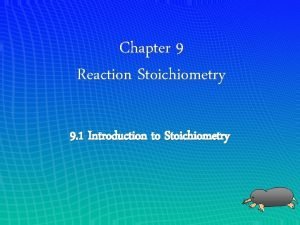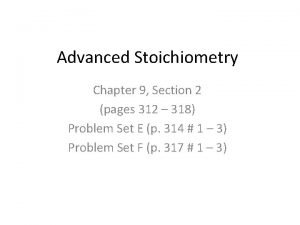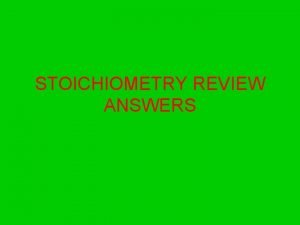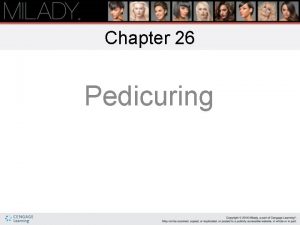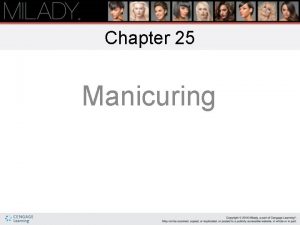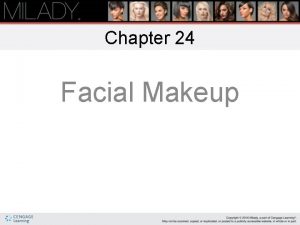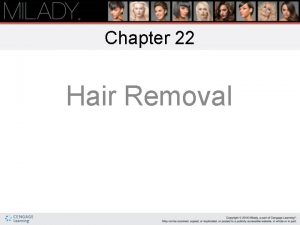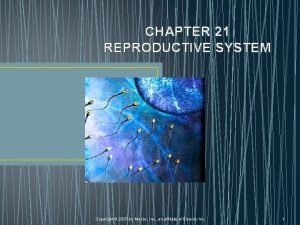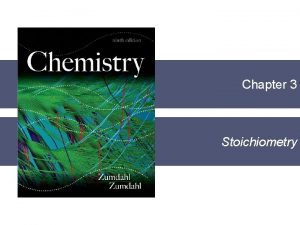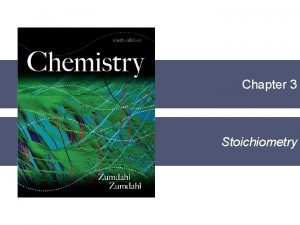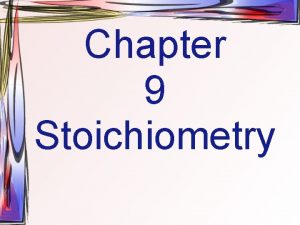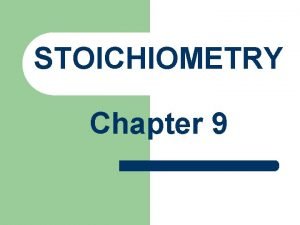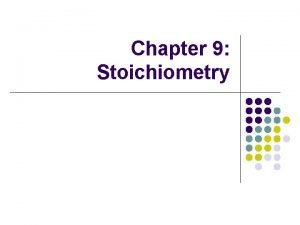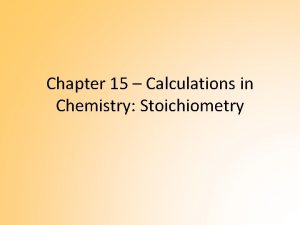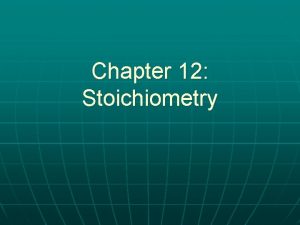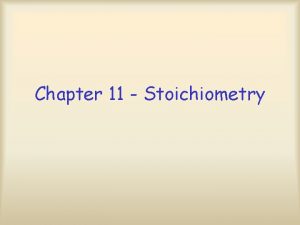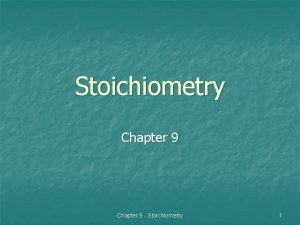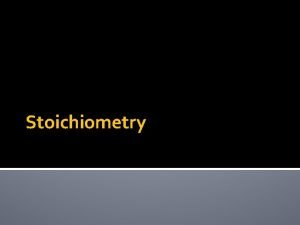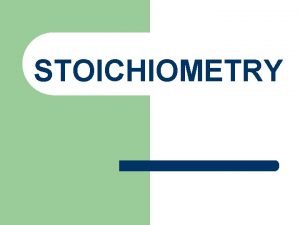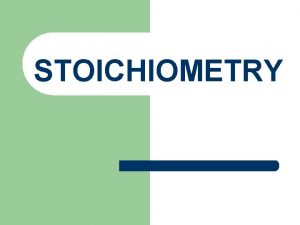Chapter 12 Review Stoichiometry 30 Questions on this
















- Slides: 16

Chapter 12 Review “Stoichiometry” 30 Questions on this test, due to calculations taking more time; be sure to bring your CALCULATOR

Chapter 12 Review n The first step in most stoichiometry problems is to ____. n How many liters of hydrogen gas are needed to react with CS 2 to produce 2. 50 L of CH 4 at STP: 4 H 2(g) + CS 2(l) → CH 4(g) + 2 H 2 S(g)? n In a chemical reaction, the mass of the products ____.

Chapter 12 Review n In the following reaction: 2 CO(g) + O 2(g) → 2 CO 2(g), what is the ratio of moles of oxygen used to moles of CO 2 produced? n When iron rusts in air, iron (III) oxide is produced. How many moles of oxygen react with 2. 4 mol of iron in the rusting reaction: 4 Fe(s) + 3 O 2(g) → 2 Fe 2 O 3(s)

Chapter 12 Review n Which of the following is true for: C 5 H 12(l) + 8 O 2(g) → 5 CO 2(g) + 6 H 2 O(l) a) 9 moles of reactants chemically change into 11 moles of product, or b) 9 atoms of reactants chemically change into 11 atoms of product? n How many moles of aluminum react with 1. 2 mol of Fe. O: 2 Al(s) + 3 Fe. O(s) → 3 Fe(s) + Al 2 O 3(s)?

Chapter 12 Review n Which of the following is NOT true about limiting and excess reagents? a) the reactant that has the smallest given mass is the limiting reagent, or b) some of the excess reagent is left over after the reaction is complete n In every chemical reaction, ____ are conserved.

Chapter 12 Review n Which of the following is an incorrect interpretation of the equation 2 S(s) + 3 O 2(g) → 2 SO 3(g): a) 2 atoms S + 3 molecules O 2 → 2 molecules SO 3, or b) 2 g S + 3 g O 2 → 2 g SO 3? n The calculation of quantities in chemical equations is called ____. n What is conserved in this reaction: N 2(g) + 3 F 2(g) → 2 NF 3(g)?

Chapter 12 Review n When 0. 1 mol of Ca reacts with 880 g water, 2. 24 L of hydrogen gas forms (at STP). How would the amount of hydrogen produced change if the volume of water was decreased to 440 m. L (440 g)? n When two substances react to form products, the reactant which is used up is called the ____.

Chapter 12 Review n Which of the following is NOT true about “yield”? a) the value of actual yield must be known to calculate percent yield, or b) the actual yield may be different from theoretical yield because insufficient limiting reagent was used?

Chapter 12 Review n If 1 egg and 1/3 cup of oil are needed for each bag of brownie mix, how many bags of brownie mix do you need if you want to use up a total of 3 eggs and 1 cup of oil? n In a reaction between copper metal and silver nitrate, 12. 7 g Cu produced 38. 1 g Ag. What is the percent yield of silver in this reaction?

Chapter 12 Review n Which of the following is true about 3 Na. HCO 3 + C 6 H 8 O 7 → 3 CO 2 + 3 H 2 O + Na 3 C 6 H 5 O 7 a) 22. 4 L CO 2 are produced for every liter of C 6 H 8 O 7 reacted, or b) 1 mole of water is produced for every mole of carbon dioxide produced? n Which type of stoichiometric calculation does not require the use of the molar mass?

Chapter 12 Review n Which of the following is NOT a reason why actual yield is less than theoretical yield: a) impure reactant present, or b) conservation of mass? n What is conserved in this reaction: H 2(g) + Cl 2(g) → 2 HCl(g)? n In any chemical reaction, the quantities that are preserved are __.

Chapter 12 Review n When an equation is used to calculate the amount of product that will form during a reaction, then the value obtained is called the ____. n How many grams of Na. Cl could be produced from 103. 0 g Na reacting with 13. 0 L of Cl 2 at STP?

Chapter 12 Review n How many grams of CO are needed to react with an excess of Fe 2 O 3 to produce 209. 7 g Fe? Fe 2 O 3(s) + 3 CO(g) → 3 CO 2(g) + 2 Fe(s) n How many liters of O 2 are needed to react completely with 45. 0 L of H 2 S at STP? 2 H 2 S(g) + 3 O 2(g) → 2 SO 2(g) + 2 H 2 O(g)

Chapter 12 Review n If 8. 6 L of H 2 reacted with 4. 3 L of O 2 at STP, what is the volume of the gaseous water collected? 2 H 2(g) + O 2(g) → 2 H 2 O(g) n If 8. 00 mol of NH 3 reacted with 14. 0 mol of O 2, how many moles of H 2 O will be produced? 4 NH 3(g) + 7 O 2(g) → 4 NO 2(g) + 6 H 2 O(g)

Chapter 12 Review n If a tricycle factory ordered 33, 432 wheels in 2002 and used all of them, how many tricycles did the factory produce? (Assume all wheels are identical) n If O 2 was the excess reagent, 8. 3 mol of H 2 S were consumed, and 137. 1 g of water were collected, what is the percent yield of this reaction? 2 H 2 S(g) + 3 O 2(g) → 2 SO 2(g) + 2 H 2 O(g)

Chapter 12 Review
 Modern chemistry chapter 9 stoichiometry test b answers
Modern chemistry chapter 9 stoichiometry test b answers Stoichiometry introduction
Stoichiometry introduction Percentage yield
Percentage yield Stoichiometry chapter 9 test
Stoichiometry chapter 9 test Chapter 11 study guide stoichiometry
Chapter 11 study guide stoichiometry The calculation of quantities in chemical equations
The calculation of quantities in chemical equations Chapter review motion part a vocabulary review answer key
Chapter review motion part a vocabulary review answer key Lord of the flies chapter 8 and 9 summary
Lord of the flies chapter 8 and 9 summary Chapter 8 skin disorders and diseases
Chapter 8 skin disorders and diseases Light cured gel enhancements should be maintained _____.
Light cured gel enhancements should be maintained _____. Name 5 pieces of equipment unique to pedicures.
Name 5 pieces of equipment unique to pedicures. Chapter 25 milady review questions
Chapter 25 milady review questions List eight types of facial cosmetics and how they are used
List eight types of facial cosmetics and how they are used Skin care objectives
Skin care objectives Milady chapter 22 review questions
Milady chapter 22 review questions Copyright
Copyright How often should the hair be shampooed milady
How often should the hair be shampooed milady

